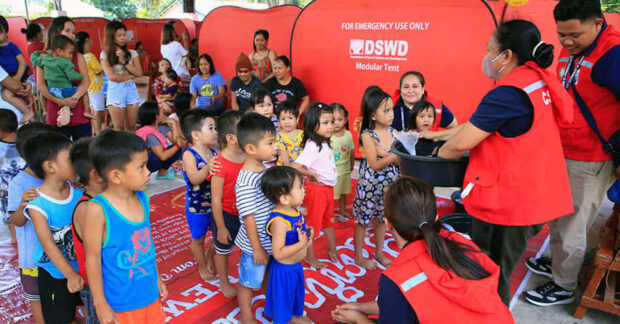DepEd extends stay of landslide evacuees in Davao de Oro schools

KEEP CHILDREN BUSY | Children of families displaced by the Davao de Oro landslide take part in a community painting workshop and other activities at an evacuation site in Mawab town. They are among more than 3,000 people displaced by the Feb. 6, 2024 landslide in Barangay Masara of Maco town that killed nearly 100 people. (Photo from the Davao de Oro Information Office)
TAGUM CITY, Davao del Norte, Philippines — Officials of the Department of Education (DepEd) in Davao de Oro province have allowed the extended use of schools as evacuation centers for survivors and other affected families of the Feb. 6 deadly landslide in Maco town, as the local government has yet to complete the temporary relocation sites for displaced villagers.
Davao de Oro Schools Division superintendent Cristy Epe said the decision to allow the use of schools as evacuation centers beyond their earlier 15-day moratorium came following the request of Maco Mayor Arthur Carlos Voltaire Rimando.
According to Epe, the mayor said that the evacuees from Masara and other communities classified as high risk for landslides still needed places to stay until March 15 when the local government shall have completed the preparation for their relocation.
Urgent request
“Due to the call of urgency and since this is for survival, we grant the request of Mayor Rimando. But we will not stop our learning-teaching process. We will be utilizing both [in-person] and blended learning [modalities],” Epe said.
The massive Feb. 6 landslide, which buried Zone 1 of Barangay Masara and killed 98 people with eight others still missing, forced the evacuation of more than 5,000 people from the village, as well as other landslide-prone communities in the neighboring villages of Mainit, Elizalde, Tagbaros, Teresa and Panibasan, all in Maco. The landslide also led to the closure of six public schools and one private-run institution in Maco, displacing 4,323 learners, the provincial education chief said.
Article continues after this advertisementAs of Feb. 29, at least 1,130 displaced families comprising 3,840 people were still staying in eight schools that served as evacuation centers in nearby Mawab town, according to Joel Penido, Maco disaster response cluster head.
Article continues after this advertisementAmong the schools being used as evacuation sites in Mawab town of Davao de Oro include the Andili National High School, Nuevo Iloco Elementary and National High School, Nueva Visayas Elementary School, Lorenzo Sarmiento National High School, Panibasan Elementary School, Panibasan National High School and Elizalde Elementary School.
Most Maco schools that had suspended classes in the wake of the landslide have reopened on Feb. 19, even as learners from Masara and other landslide-prone communities remained in evacuation centers or stayed with their relatives in safer areas.
Education doesn’t stop
To help displaced learners compensate for their absence from class, Epe said her office gave some teachers temporary reassignment orders to allow them to go to evacuation sites and teach. She called the program, “Tuloy ang Kaalaman,” which translates to learning continues.
“Through our Tuloy ang Kaalaman [program], learners are taught with the basic competencies like reading, science and math,” Epe said, adding that “teachers of the affected learners will go to the evacuation sites to teach and be given temporary reassignment orders.” Epe acknowledged this would not be an easy task for both learners and teachers but it was important to ensure that learners continued their education despite their situation, she said. “Our approach would be that of a tutorial type because learners cannot stay there for six hours and they have to take turns,” she said.
Davao de Oro was severely affected by the flooding brought by incessant rains caused by the shear line that prevailed over most of the Davao region in the early to middle part of January, and by the trough of a low pressure area that occurred during later in the month and towards the early part of February.
READ: Landslide victims’ kin brace for worst
These weather events led to the suspension of classes for an equivalent of 20 days, or more than 10 percent of the 180-day class time for an entire school year, Epe said.
Meanwhile, donations continued to pour for the evacuees. However, local government and social welfare officials have appealed to prospective benefactors to coordinate with them before extending noncash assistance to avoid overwhelming the evacuees with surplus relief goods, like used clothing.